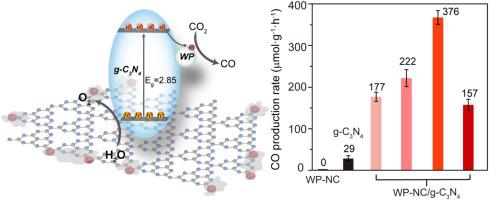Applied Catalysis B: Environment and Energy ( IF 20.2 ) Pub Date : 2021-01-07 , DOI: 10.1016/j.apcatb.2021.119879
Xiandi Zhang , Jia Yan , Fangyuan Zheng , Jiong Zhao , Lawrence Yoon Suk Lee

|
Developing metallic co-catalysts is an effective way to enhance the photocatalytic activity of semiconductor by forming the Schottky junction, but it remains challenging to unveil the design principle. Herein, a novel nanocomposite is prepared by coupling ultra-small WP nanoparticles embedded on N-doped carbon (WP NC) with 2D graphitic C3N4 (g-C3N4). The WP
NC) with 2D graphitic C3N4 (g-C3N4). The WP NC and g-C3N4 form an intimate interface via PN
NC and g-C3N4 form an intimate interface via PN chemical bonds at atomic level, which facilitates the flow of photoexcited electrons from g-C3N4 to WP
chemical bonds at atomic level, which facilitates the flow of photoexcited electrons from g-C3N4 to WP NC. Moreover, the Schottky junction formed at the interface can prevent the charge-carrier recombination in the WP
NC. Moreover, the Schottky junction formed at the interface can prevent the charge-carrier recombination in the WP NC/g-C3N4 composite and thus significantly enhance the photocatalytic CO production rate from 29 (bare g-C3N4) to 376 μmol g−1 h−1. As the first example of WP applied on the photocatalytic CO2 reduction, this work demonstrates the potential of metallic WP as a co-catalyst in photocatalysis and provides a useful guide on the phosphide-based material designing.
NC/g-C3N4 composite and thus significantly enhance the photocatalytic CO production rate from 29 (bare g-C3N4) to 376 μmol g−1 h−1. As the first example of WP applied on the photocatalytic CO2 reduction, this work demonstrates the potential of metallic WP as a co-catalyst in photocatalysis and provides a useful guide on the phosphide-based material designing.
中文翻译:

设计可湿性粉剂纳米粒子与gC 3 N 4之间的界面上的电荷转移路径,以高度增强光催化性CO 2还原反应
开发金属助催化剂是通过形成肖特基结来增强半导体的光催化活性的有效方法,但是揭示设计原理仍然具有挑战性。本文中,通过将嵌入在N掺杂碳(WP  NC)上的超小WP纳米颗粒与2D石墨C 3 N 4(gC 3 N 4)偶联,制备了新型纳米复合材料。WP
NC)上的超小WP纳米颗粒与2D石墨C 3 N 4(gC 3 N 4)偶联,制备了新型纳米复合材料。WP  NC和gC 3 N 4通过
NC和gC 3 N 4通过 原子级PN化学键形成紧密的界面,这促进了光激发电子从gC 3 N 4到WP的流动
原子级PN化学键形成紧密的界面,这促进了光激发电子从gC 3 N 4到WP的流动 NC。此外,在界面处形成的肖特基结可以防止WP
NC。此外,在界面处形成的肖特基结可以防止WP  NC / gC 3 N 4复合材料中的电荷-载流子复合,从而显着提高光催化CO的生产速率,从29(裸gC 3 N 4)提高到376μmolg -1 h -1。作为将WP用于光催化还原CO 2的第一个实例,这项工作证明了金属WP作为光催化助催化剂的潜力,并为基于磷化物的材料设计提供了有用的指导。
NC / gC 3 N 4复合材料中的电荷-载流子复合,从而显着提高光催化CO的生产速率,从29(裸gC 3 N 4)提高到376μmolg -1 h -1。作为将WP用于光催化还原CO 2的第一个实例,这项工作证明了金属WP作为光催化助催化剂的潜力,并为基于磷化物的材料设计提供了有用的指导。































 京公网安备 11010802027423号
京公网安备 11010802027423号